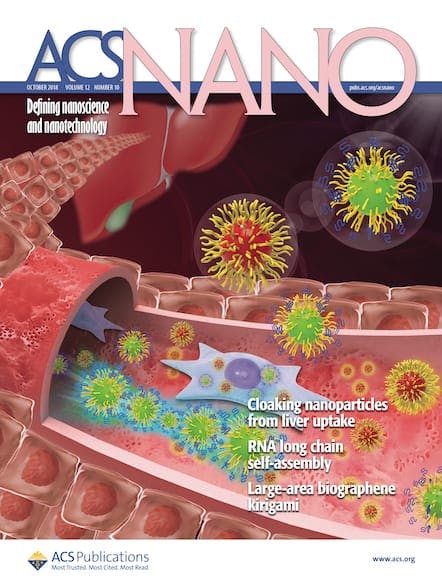ACS journals feature the work of many amazing chemistry researchers, but none quite as productive as Dr. Zhong Lin Wang. At the 254th ACS National Meeting and Exposition, Wang was honored as ACS Publications’ most prolific author. The honor was announced via a photo mosaic, which used images submitted by event attendees to assemble a […]

ACS journals feature the work of many amazing chemistry researchers, but none quite as productive as Dr. Zhong Lin Wang. At the 254th ACS National Meeting and Exposition, Wang was honored as ACS Publications’ most prolific author. The honor was announced via a photo mosaic, which used images submitted by event attendees to assemble a portrait of the most prolific author. While Dr. Wang was unable to attend the event in person, he did speak to attendees via video chat and his daughter, Aurelia Wang, was on hand to help celebrate his achievements.
What drives Wang’s remarkable productivity? What can ACS Axial readers learn from him about getting more done in the lab? Read an interview with Wang and discover his research published in ACS journals.
What first attracted you to the study of chemistry? Do you remember what made you decide to pursue a career in the lab?
I was attracted to chemistry in my high school years. Although there was no experimental facility at all [at my school] back then, I was deeply impressed by watching chemical reactions occurs in a test tube. I remember asking my teacher a question: What is a hybridized valence state? He told me, “You cannot understand this now because you are too young, but wait until you get to college.”
What sparked your interest in energy research?
I have been engaged in nanomaterials and nanoscale characterization research since 1983. I always think about how can we utilize nanomaterials to make changes in our life. Besides the beauty provided by nanoscale structures, how they can be applied to serve the world? I first started in energy research in 2005. Ever since then, energy has been one of the most important focus areas of my research. But my energy research is different from most people, who are focused on organic catalysis, LEDs, solar cells, batteries, and supercapacitors. I use organic materials to convert body motion energy into electric power, which I call an organic nanogenerator.
What do you think the future of energy research looks like? Are there particular energy solutions you’re especially excited about?
We are making good progress in energy studies, but to solve the world’s energy needs at a large-scale is very challenging. I think the energy research we do today can only contribute a small portion of the world’s total energy consumption, in comparison with the energy we get from combustion-based fossil fuel use. However, with the new fields of the internet of things, sensor networks and big data, we need a huge number of small energy sources for powering mobile sensors and related networks. These so-called “micro-grid power sources” are desperately needed for the era of the internet of things. I think that our nanogenerator is ideal for this type of application since it harvests energy from our living environment for powering small sensors and mobile electronics.
What are the biggest remaining barriers to wide adoption of nanogenerators?
Converting mechanical energy into electric power was not a traditional area for chemists, but mechanical engineers. We chemists are used to studying organic solar cell and organic LEDs. But now chemists and materials scientists can fabricate triboelectric nanogenerators using the materials they have synthesized. I think that people have to overcome this mindset and realize that nanogenerators are a new and exciting field. They can have a wide range of applications in fields such as flexible electronics, wearable fiber electronics, health care, security, pollution control, and motion sensors.
With increased interest and worldwide research starting in the field of nanogenerators, our first challenge is we now have to find the killer applications of these nanogenerators. I think that breakthrough area will be found very soon, with the continuous increase in the output power of nanogenerators, particularly in the area of self-powered systems and sensors. The second challenge we need to overcome is the material’s durability and the device’s stability, as well as its lifetime. Solving this will open up new research areas for chemists and materials scientists, especially nanomaterials and polymer people. The third challenge would be the packaging technology and system integration, which is important for applying nanogenerators in our real life.
Did managing students and other researchers come naturally to you? What have you learned over your career of managing people that you wish you’d known at the start?
Our research attracts a wide range of students with all kinds of background, such as chemistry, physics, materials science, electrical engineering, mechanical engineering, and even medical sciences. We can fit them all into our research team because we are doing a systemic approach. Students are excited when they can directly see what they have made at work.
You’re being honored for being an incredibly prolific author. How do you manage to get so much done in the lab? Do you have a productivity tip for ACS Axial readers?
Nanogenerators and piezotronics are two fields that we pioneered. Our publications have been focused on the advances in these two new fields. I have been prolific not only because I work very hard, but also because I have many outstanding students, postdocs, and collaborators who also work very hard and dedicated.
I always stay on top of things and remain hands-on. I work very closely with my people and give them detailed advice. I always emphasize to them is that our research has to be high quality, with a high degree of innovation. We do research to advance our scientific understanding and technology innovations in nanogenerator and piezotronics fields, which we pioneered, rather than just publishing. Publications are the means for communicating and reporting to the world what we have done and establishing these new fields. Our goal is to make these two fields truly useful for the world.
The tips I can give are as follows:
- If you have 5 minutes, do a task that takes 5 min things; each day is made of many 5 minutes.
- Do not look at the same email twice. Process your email immediately as you receive it. If you can get it done today, do not wait until tomorrow.
You’ve published more than 300 papers in ACS journals. Do you have any favorite papers?
Yes! I have a number of very important papers published in ACS journals. Here are a few.
These two papers establish the physics foundation of piezotronics:
Piezoelectric-Potential-Controlled Polarity-Reversible Schottky Diodes and Switches of ZnO Wires
Nano Lett., 2008, 8 (11), pp 3973–3977
DOI: 10.1021/nl802497e
Flexible Piezotronic Strain Sensor
Nano Lett., 2008, 8 (9), pp 3035–3040
DOI: 10.1021/nl802367t
These three papers created the field of piezo-phototronics and its basic physics model:
Optimizing the Power Output of a ZnO Photocell by Piezopotential
ACS Nano, 2010, 4 (7), pp 4220–4224
DOI: 10.1021/nn101004
Enhancing Sensitivity of a Single ZnO Micro-/Nanowire Photodetector by Piezo-phototronic Effect
ACS Nano, 2010, 4 (10), pp 6285–6291
DOI: 10.1021/nn1022878
Enhancing Light Emission of ZnO Microwire-Based Diodes by Piezo-Phototronic Effect
Nano Lett., 2011, 11 (9), pp 4012–4017
DOI: 10.1021/nl202619d
This paper points out the killer application of the triboelectric nanogenerators at low-frequency in comparison to the traditional electromagnetic generator, which will have a huge impact on the engineering applications of nanogenerators.
Harvesting Low-Frequency (<5 Hz) Irregular Mechanical Energy: A Possible Killer Application of Triboelectric Nanogenerator
ACS Nano, 2016, 10 (4), pp 4797–4805
DOI: 10.1021/acsnano.6b01569
This was the first paper on a hybrid cell for harvesting multi-type of energy using a single device. It opens the field of hybrid energy cell.
Nanowire Structured Hybrid Cell for Concurrently Scavenging Solar and Mechanical Energies
J. Am. Chem. Soc., 2009, 131 (16), pp 5866–5872
DOI: 10.1021/ja810158x
